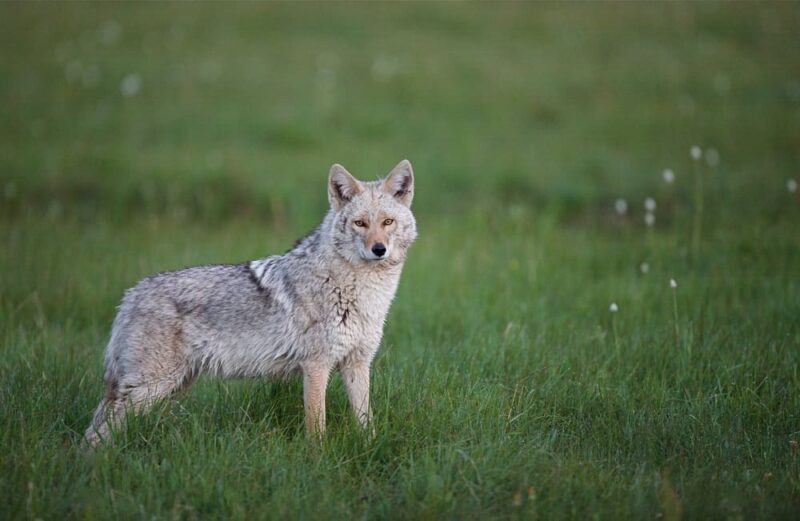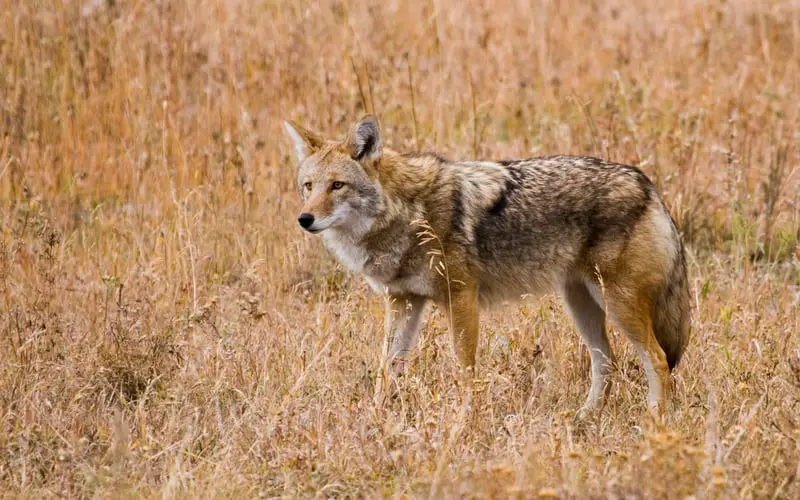Reports of coyote sightings are on the rise in Kentucky. According to the Kentucky Department of Fish & Wildlife Resources, coyotes are doing well in the bluegrass state. In fact, they are regularly seen in all 120 Kentucky counties.
Coyotes are not Kentucky natives. In fact, they only arrived in the state in the second half of the twentieth century. Coyotes are adaptable to new environments and new territory. What’s more, they thrive despite human attempts to limit their numbers.
In Native American lore, the coyote is always a trickster. In real life, the coyote is an embodiment of its trickster image. When they are not hunted or harassed, coyotes easily adapt to suburban areas. Coyote attacks on humans are rare. Generally, coyotes do not pose a threat to humans. In fact, in most cases, people are unaware when they have coyotes living in close proximity to them. This is because coyotes go to great pains to avoid human contact.
However, coyotes that have become habituated to human sources of food, whether that be food scraps, pet food, or garbage, are a threat to people. Once they have lost their fear of people, they become a nuisance to pet owners and a danger to livestock, domestic cats, small dogs, and even small children. See
The Kentucky Fish and Game Commission has a list of recommendations to help avoid coyote-human conflicts. We’ll talk about these, along with other Kentucky coyote-related stuff, in the paragraphs below.
Where did Kentucky’s coyotes come from?
As stated in the opening section, coyotes are not native to the state of Kentucky. Prior to the 1950s, this member of the canine family was confined primarily to western North America, primarily the western United States.
However, after mountain lions and wolves were extirpated from their former habitat in the midwestern and eastern United States, coyotes began moving east, filling the void left by the missing large predators. Coyotes first came to Kentucky sometime in the 1970s, crossing the Mississippi River at a time when it was frozen over.

Living with Urban Coyotes
Up until recently, coyote sightings in Kentucky were a rare occurrence. However, as stated above, these canine predators now live throughout the state. People are often shocked to see them in suburban and urban areas. Sometimes People are unaware that coyotes are living close by. This is because, in residential areas, coyotes are less likely to be out and about during daylight hours.
In a May 1, 2017, article in the Kentucky Afield magazine which is the official publication of the Kentucky Department of Fish and Wildlife, wildlife biologist Laura Palmer, says the following. “Since total eradication of coyotes is not possible, having a basic understanding of these wild animals, which can range in color from reddish to tan to grizzled gray and black, can ease concerns and limit potential conflicts.”
Secure fences and crawl spaces to keep unwanted animals, such as coyotes, at bay
Kentucky Department of Fish and Wildlife Resources suggests that people plug holes under fences around yards and gardens and block access to crawl spaces to help avoid a coyote problem. See
It’s also a good idea to install fence top rollers See that denies animals like coyotes traction if they should attempt to scale your fence.
Use negative reinforcement to discourage coyotes from entering your property.
If you observe a coyote on your property, immediately make it a negative experience for the coyote. The best way is to act aggressively toward the animal and make loud noises, such as yelling or using noisemakers like an air horn, for example. If you can help the coyote to retain its fear of humans, it’ll be a better outcome for both it and you.
It’s also a good idea to install outside lights and motion-activated lighting.

Make sure that a coyote can’t find an easy meal on your property.
Coyotes are omnivores. In other words, they eat a wide variety of foods. Their diet includes small animals such as rodents, rabbits, opossums, and amphibians. They also eat carrion, insects, bird eggs, and fruit.
When wild foods are limited, they are more likely to take advantage of food from human sources. To avoid attracting coyotes to your property, you should eliminate any potential food sources on your property. For example, secure garbage, and take dog food and cat food inside after dark.
Also, a lot of people have backyard barbeques. Remember to thoroughly clean grills, including cooking surfaces and grease traps. Otherwise, you’re leaving a strong smell attractant to any coyote in the area.
What’s more, it’s a bad idea to feed wild animals such as raccoons, opossums, deer, or feral cats. Also, remember that bird feeders attract rodents, opossums, and raccoons. In turn, this attracts coyotes to your property.
If you live in an area where they are active, these same tips will make your property less attractive to black bears.
Keep your pets safe.
When walking your dog be sure to be sure to use a short, non-retractable leash that is highly visible to the coyote. The reason for this is that they are less likely to attack a dog if they see it as part of you. What’s more, you should change up your walking routine. In other words, do not walk your dog at the same time or on the same route every day.
Coyotes are observant and learn patterns. Always clean up dog droppings, as they will attract coyotes. Finally, never let your dog chase a coyote. The coyote will naturally defend itself. This increases the chance that your dog will be injured.
The time of year, when coyote sightings increase, is during the winter mating season. During the breeding season, there is the potential that coyotes will be more territorial and less tolerant of dogs.
Potential coyote den sites include hollow trees, brush piles or trash piles, abandoned buildings, former ground hog burrows, or burrows that they have excavated themselves.
If you happen to know where a coyote den site is located, stay away from it. Coyotes will be more aggressive if are protecting their pups.
Coyotes are also more likely to be seen during the late summer and fall. The reason is that this is the time of year when family groups disperse, and young adult coyotes venture out to establish their own territories.

Coyote Hunting in Kentucky
In Kentucky, it’s legal for coyote hunters to hunt day or night on both private land and public lands year-round. What’s more, there is no bag limit for coyotes in Kentucky.
Coyote hunters must possess a valid hunting license or be license-exempt. “In Kentucky, resident and non-resident children under the age of twelve are license-exempt for all game animals with the exception of elk.”
Additionally, coyote hunters must obtain permission from landowners to hunt on private property in Kentucky.
In Kentucky, it’s only legal to use artificial light or night vision equipment for two different time periods in the course of the year. The times when elimination equipment is legal are from Dec. 1 through March 31, and from May 16 through June 30.
In Kentucky, electronic calls and mouth calls that imitate wounded prey are both legal to use.
Also, see:
Recent Posts
The only venomous snakes in Washington State are Northern Pacific Rattlesnakes. The Northern Pacific Rattlesnake (Crotalus oreganus oreganus) is a sub-species of the Western Rattlesnake. Anyone...
Skunks are not classified as true hibernators. But they go into a state of torpor when the weather gets cold. Skunks are light sleep hibernators, along with opossums, bears, and raccoons. ...

